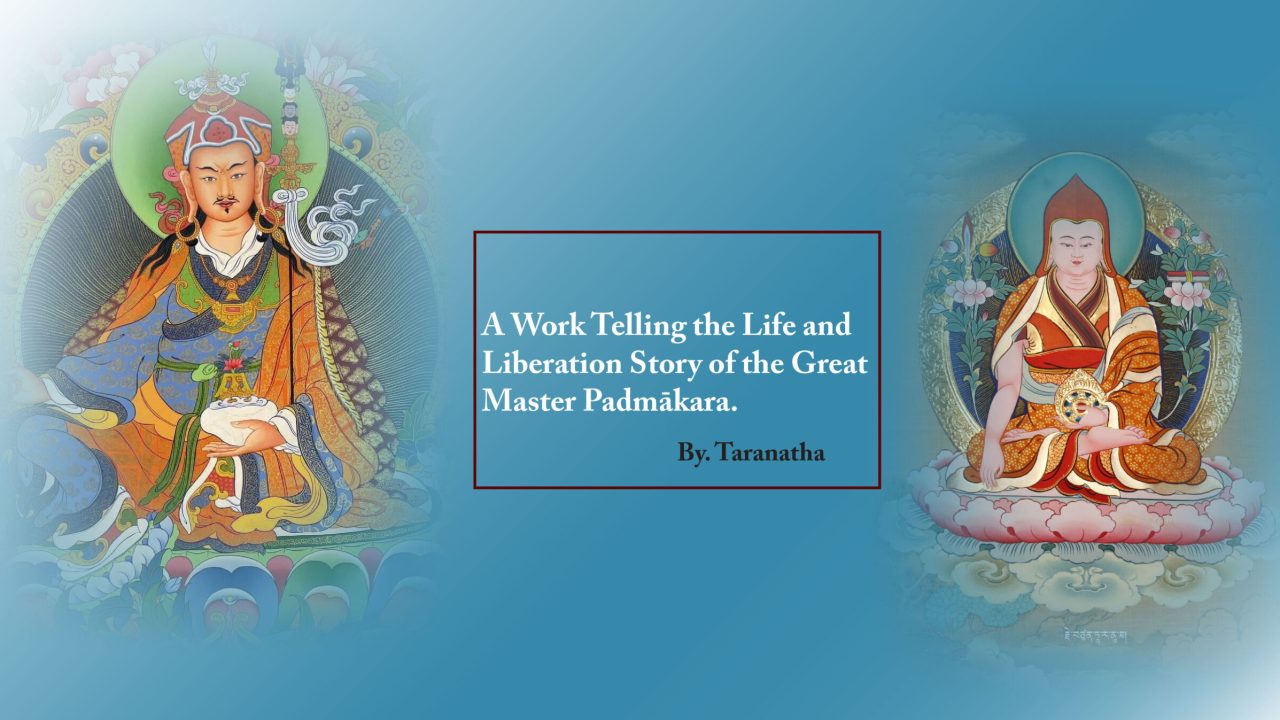Part 19
The place where the ḍākinīs were first bound under oath was called Lampasdyā, where, in the cave, there is a hearth made by his own hand. The latter two bindings were done at a place called Alapasdyā, where there are about a thousand imprints left when the kīla-daggers struck the ḍākinīs. Activity kīla-daggers do not usually remain in the domain of ordinary beings. Yet, whereas all the others disappeared, one still remains, so that beings in the future would have faith. It is said the wisdom deity dissolved into the body of the Master, and thus a single material kīla-dagger was left behind. No substance, such as stone, wood, copper or iron, compares to it. It is as if, rather than having been made, it had spontaneously appeared, measuring about the length of three people. The story goes that at first there was a strong kīla-dagger made of wood. During practice, it increased vastly in size and could be changed to any size with the mind, could move and speak and so on, just like the actual deity. It became a whirling firebrand, too. When one of the main piśacī mantradhārinī made her body the size of Mount Meru and was just about to flee, the kīla-dagger also became the size of a mountain and struck her down. Later, it is said, the wisdom deity dissolved into the body of the Master, the brilliant light and blazing fire calmed, and this kīla-dagger was what remained.
Conclusion
I arranged this history of the Master as follows: There are a few accounts that are known in the Noble Land of India, such as the oral transmission the great accomplished master Śāntigupta, and there is an even more detailed and extensive account from the lineage of the master Devakara from Drāmiḍa. I heard these stories from direct disciples of both of these two masters. In addition, the history of his activities on behalf of the beings of Tibet appears in many similar, reliable, old documents that I have complete faith in. I have also heard a tiny part of the instructions of the Master that originated in Drāmiḍa, and that was transmitted through Indian scholars. Although I have not actually seen the historical texts that tell the Indian tales, the tales are included in the texts of the history of our lineage of teachers, both scholars and masters. I have also seen many texts that contain the history of the spread of the Dharma to Drāmiḍa. They all conform to the stainless teachings of the sublime beings, the scholars and the accomplished-ones, that are transmitted from ear to ear. This being so, not even the slightest part of what is put together here should be abbreviated or removed, but rather it should be supplemented with many more truthful and amazing episodes. It is said in the Indian histories that the Master also worked for the benefit of beings on the island of Hurmuju and places such as Sikadhara, Dharmakośa and Rukma, but I was unable to find those accounts. Although I have also seen many quite wonderful stories in the context of expounding the meaning of the extraordinary Dharma instructions of Tibet, there are too many to include here.
In conclusion,
Some unintelligent people, using only blind faith, make up many stories in order to increase the faith of beings.
Most people are very stupid, so, regardless of whether they are false or meaningless, it is possible this would increase their faith.
When the learned see and hear them, they are embarrassed, and thereby doubts are generated with regard to even sublime beings and pure teachings. Can there be a more harmful action than this work of Māra?
Abandon now any doubts about this strange story, for there is no nonsense written here.
This short composition could outshine a great volume of invented stories, one-hundredfold.
Through the merit of writing this, may I attain the level of the Master and lead all beings to liberation!
Although I have told this clear, pure and faithful story, it was only through the blessings of the Master entering my heart.
I have no wish for fame in the world, or to have followers, or to create a fierce dispute.
It is a condition for my faith and the faith of those who follow my words—nectar to the ears and minds of the learned.
This life and liberation of the emanation of the vajra-speech of all the tathāgatas, the Great Master of Uḍḍiyāna, Padmasambhava, is called Three Reasons for Confidence. It was motivated by my companion, Tsangnyön Kunga Palzang, who stays and travels with me, thinking it would nourish my faith. It was composed by me, Tāranātha, a vagabond, aged thirty-six, in the Jomo hermitage in Nakgyal.
May virtue increase! Maṅgalam!
| Translated by David Teasdale, 2019. (Many thanks to Kaleb Yaniger, Peter Woods, Libby Hogg and Stefan Mang for kindly providing suggestions and clarifications.)
